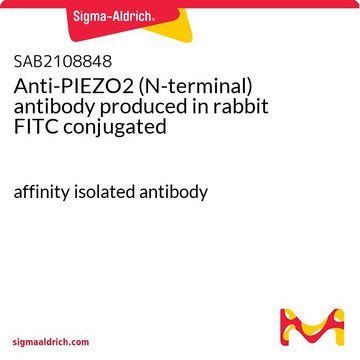SAB2108849
Anti-PIEZO2 (N-terminal) antibody produced in rabbit HRP conjugated
affinity isolated antibody
Synonym(s):
GH, GH-N, GHN, IGHD1B, hGH-N
About This Item
biological source
rabbit
conjugate
peroxidase conjugate
antibody form
affinity isolated antibody
antibody product type
primary antibodies
clone
polyclonal
form
buffered aqueous solution
mol wt
77 kDa
species reactivity (predicted by homology)
mouse, human, canine, rat, horse, bovine, guinea pig, rabbit
concentration
0.5 mg/mL
shipped in
wet ice
1 of 4
This Item | SAB2108848 | HPA031975 | SAB2108846 |
|---|---|---|---|
| biological source rabbit | biological source rabbit | biological source rabbit | biological source rabbit |
| antibody form affinity isolated antibody | antibody form affinity isolated antibody | antibody form affinity isolated antibody | antibody form affinity isolated antibody |
| conjugate peroxidase conjugate | conjugate FITC conjugate | conjugate unconjugated | conjugate unconjugated |
| form buffered aqueous solution | form buffered aqueous solution | form buffered aqueous glycerol solution | form buffered aqueous solution |
| storage temp. −20°C | storage temp. −20°C | storage temp. −20°C | storage temp. −20°C |
| clone polyclonal | clone polyclonal | clone polyclonal | clone polyclonal |
General description
Immunogen
Sequence
Physical form
Disclaimer
Not finding the right product?
Try our Product Selector Tool.
Storage Class
12 - Non Combustible Liquids
wgk_germany
WGK 1
flash_point_f
Not applicable
flash_point_c
Not applicable
Choose from one of the most recent versions:
Certificates of Analysis (COA)
It looks like we've run into a problem, but you can still download Certificates of Analysis from our Documents section.
If you need assistance, please contact Customer Support
Already Own This Product?
Find documentation for the products that you have recently purchased in the Document Library.
Related Content
We have applied our revolutionary CompoZr Zinc Finger Nuclease technology to create an unparalleled range of genetically modified mammalian cell lines for use in areas, such as target validation, drug discovery and drug development.
Our team of scientists has experience in all areas of research including Life Science, Material Science, Chemical Synthesis, Chromatography, Analytical and many others.
Contact Technical Service


